
Hardly any dish in the kitchen can do without the right spice. So why not try growing some aromatic plants yourself in your home garden? This article explains how this works with the right plan.
To the point
- There are many different spice plants
- Mostly sunny location in the garden is preferred
- many heat-loving species have to overwinter indoors
Table of contents
- Grow spice plants
- Spice plants from A – B
- D-G
- Plants with I
- Spice plants with K
- Spice plants for growing L – O
- P-R
- Plants with S
- Spice plants for cultivation with W
- Planting plan for spice plants
- frequently asked Questions
Grow spice plants
There are an almost endless number of spices. The most popular include mustard, vanilla, cinnamon, anise and many others, which are commonly used in the kitchen for savory and sweet dishes. Some spice plants you can grow it yourself in the garden. However, this is limited to plants that are native or at least have no special needs.
Spice plants from A – B
anise (Pimpinella anisum)
In addition to the seeds, the young leaves of the anise plant can also be used as an herbal addition to salads, soups and stews. You can also use the plant's flowers as an edible decoration, e.g. b. Use on desserts.

- Characteristics: annual perennial, up to 70 cm high
- Plant: sow indoors from April or outdoors from May, do not plant after other umbelliferous plants, sunny, warm location in the garden
- Watering and fertilizing: keep moist, fertilizer not necessary
- Harvest time: from September
- plant parts used: mature seeds
Wild garlic (Allium ursinum)
The foliage of wild garlic is similar to that of poisonous lily of the valley and the Autumn crocuses. Therefore, be careful when harvesting and pay attention to the intense garlic-like smell, which has earned it the common name “wild garlic.”

- Characteristics: low, perennial, herbaceous plant, spreads independently
- Plant: partial shade to shady, spring or autumn
- Watering and fertilizing: keep moist
- Harvest time: from March
- plant parts used: leaves and flowers
Chili, Spanish pepper (Capsicum annuum)
The spiciness of chilies is caused by the alkaloid capsaicin, which is concentrated primarily in the white membranes and seeds of the fruit. When capsaicin comes into contact with the mucous membranes in the mouth, nose, or eyes, it activates pain receptors and causes the burning sensation.

- Characteristics: mostly annual perennial, up to 80 cm high
- Plant: from February prefer in the house, plant outdoors or in a greenhouse from May, pure indoor cultivation is also possible, warm and sunny location
- Watering and fertilizing: keep evenly moist and fertilize regularly when growing in containers
- Cut: lighten things up every now and then
- Harvest time: as soon as the fruits have reached their respective level of ripeness
- plant parts used: fruits and seeds
Notice: With a little skill and practice you can Overwinter chili plants. They fruit earlier and better the following year.
D-G
dill (Anethum graveolens)
dill It is best to use it fresh as its aroma diminishes as it dries. However, you can also freeze dill for longer-term preservation. Dill is an extremely flexible herb that can be added to many dishes, e.g. b. Adds a refreshing and spicy touch to herb butter, soups or fish dishes.

- Characteristics: annual, herbaceous umbelliferous plant, up to 100 cm high
- Plant: sow from April, sunny to partially shaded
- Watering and fertilizing: easy to care for, water only when dry
- Harvest time: from spring to summer
- plant parts used: Leaves
Notice: Dill plants are popular food sources for the caterpillars of the swallowtail butterfly (Papilio machaon). These striking yellow-black butterflies lay their eggs on the cultivated spice plants, and the hatched caterpillars feed on the leaves. By growing dill in your garden, you can help protect habitats and food sources for swallowtail caterpillars and others Butterflies to accomplish.
fennel (Foeniculum vulgare)
Fennel tea is often used as a home remedy for digestive problems and is particularly popular with infants and young children to relieve colic.

- Characteristics: biennial perennial, up to 2 meters high
- Plant: Either grow for two years using seeds or plant young plants outdoors from April onwards, sunny
- Watering and fertilizing: water when dry
- Harvest time: for leaves and flowers continuous, seeds from late summer as soon as they are ripe
- plant parts used: leaves, flowers, seeds
Clove (Syzygium aromaticum)
Cloves (Syzygium aromaticum) are the dried, still closed flower buds of the clove tree. They are known for their warm, sweet and slightly spicy taste.

- Characteristics: evergreen tree, grown in containers up to 2 m high
- Plant: in pots, not too sunny, warm location, not frost hardy
- Watering and fertilizing: keep moist, fertilize every two weeks, spray leaves
- Cut: young shoots to keep the tree in shape
- Harvest time: as soon as the buds appear
- plant parts used: buds
Plants with I
Ginger (Zingiber officinale)
Ginger is not only a medicinal plant, but also a versatile ingredient in the kitchen. Its hot, spicy taste gives many dishes a special touch. Ginger can be used fresh, dried, powdered or as ginger oil.
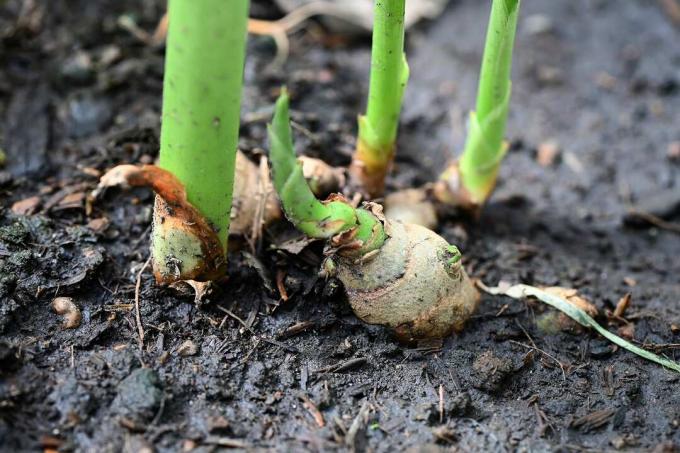
- Characteristics: produces long green leaves, up to 40 cm high
- Plant: in the house from spring, later place the pot outdoors, sunny and warm
- Watering and fertilizing: keep moist, fertilize regularly
- Harvest time: when the leaves turn yellow, dig up the rhizome
- plant parts used: rhizome
Spice plants with K
Nasturtium (Tropaeolum majus)
The flowers and leaves of the Nasturtium have a slightly spicy and peppery taste that is reminiscent of radishes. The colorful flowers are often used as an edible decoration on soups and salads. Please note, however, that cress likes to kill pests such as: b. Attracts aphids, whiteflies and spider mites.
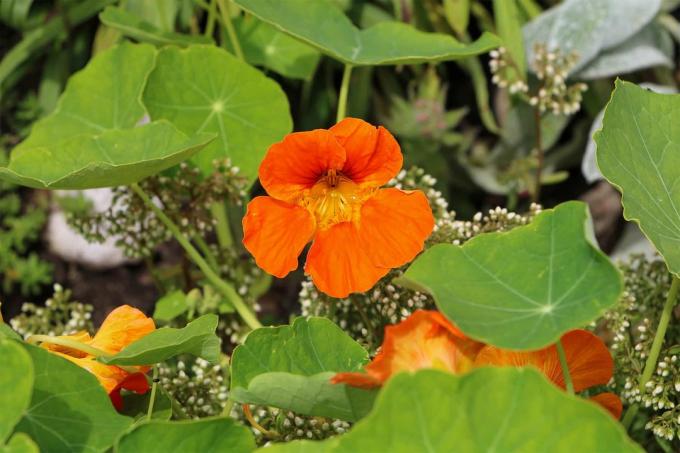
- Characteristics: annual, not hardy, climbing
- Plant: prefer indoors from April, outdoors from May, sunny
- Watering and fertilizing: keep moist, fertilize regularly in the pot
- Cut: when the cress gets too big
- Harvest time: starting in summer
- plant parts used: flowers and leaves
coriander (Coriandrum sativum)
Some people love the fresh, lemony taste of cilantro, while others find it soapy or even unpleasant. The respective taste sensation depends, among other things. a. depends on genetic predisposition.
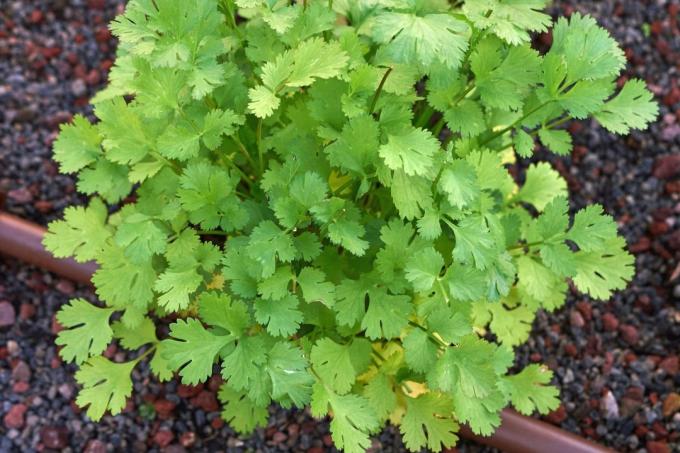
- Characteristics: annual, herbaceous growth, umbelliferous, up to 70 cm high
- Plant: Sow indoors from February, outdoors from April, sunny to partially shaded, warm location
- Watering and fertilizing: keep moist, do not fertilize, weak feeder
- Cut: leaves of leafy coriander continuous
- Harvest time: Leaf coriander already 6 weeks after sowing, seeds just before they are fully ripe
- vplant parts used: leaves or seeds
Notice: Some people love the fresh and lemony taste of cilantro, while others find it soapy or even unpleasant. The reaction to coriander depends on the genetic predisposition and the individual taste sensation.
Caraway seeds (Carum carvi)
Caraway is used to relieve digestive problems such as flatulence, stomach cramps and colic. The essential oils The seeds give the spice its characteristic taste.

- Characteristics: Umbelliferous plants, biennial, up to 100 cm high
- Plant: sow from April, light germinator, sunny to partially shaded location
- Watering and fertilizing: keep moist, do not fertilize
- Harvest time: from July
- plant parts used: seeds
Spice plants for growing L – O
lavender (Lavandula angustifolia)
The lavender oil obtained from the flowers is used in various areas. The oil is often used in aromatherapy to reduce stress and promote relaxation. The lavender flowers can also be used in the kitchen as a spice to refine desserts, drinks and in savory dishes.

- Characteristics: shrub-like growth, perennial, up to 80 cm high
- Plant: outdoors from May, sunny
- Watering and fertilizing: water only during long periods of drought, do not fertilize
- Cut: after flowering and in spring
- Harvest time: just before the flowers open
- plant parts used: Blossoms
marjoram (Origanum majorana)
marjoram is often confused with oregano because the leaves and flowers look very similar.
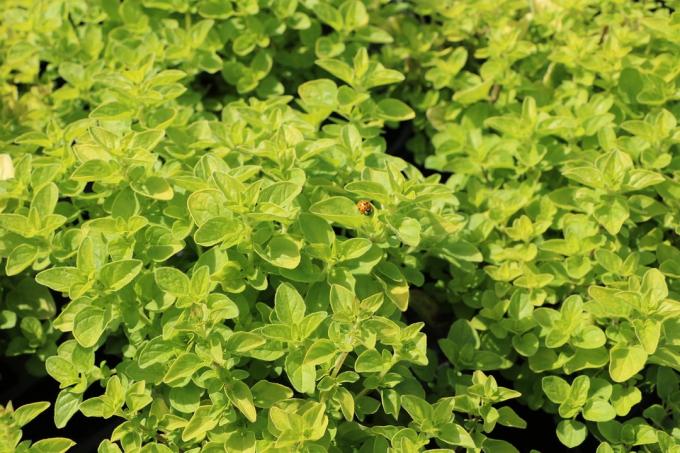
- Characteristics: Subshrub, up to 50 cm high, not hardy
- Plant: can be overwintered in a pot, otherwise as an annual in the garden, sunny, warm location, light germinator
- Watering and fertilizing: don't water too much, no fertilizer necessary
- Cut: any time in summer
- Harvest time: from June
- plant parts used: Leaves
horseradish (Armoracia rusticana)
The root of the horseradish can be grated. Horseradish is a particularly hot spice and should be dosed carefully.

- Characteristics: perennial, rampant
- Plant: Don't forget the root barrier, plant in sunny or partial shade from April
- Watering and fertilizing: keep moist, but do not fertilize
- Harvest time: from October, in frost-free weather until January
- plant parts used: Root
oregano (origanum)
The leaves of the oregano are used both fresh and dried as a spice in Mediterranean cuisine to season pizza, pasta, salads and sauces.

- Characteristics: perennial herb, up to 60 cm high
- Plant: warm, sunny location, prefer indoors from February, sow outdoors from April
- Watering and fertilizing: only water during long periods of drought, do not fertilize
- Cut: cut back in spring
- Harvest time: from early summer
- plant parts used: leaves and shoots
P-R
pepper (Piper nigrum)
Pepper is one of the most popular spices worldwide. It is obtained from the dried berries of the pepper plant and gives dishes a pleasant spiciness.

- Characteristics: perennial climbing plant, reaching several meters high
- Plant: only as a container plant, overwinter indoors
- Watering and fertilizing: water and fertilize regularly
- Cut: Plants that are too tall can be shortened
- Harvest time: about 8 months after flowering
- plant parts used: immature seeds
rosemary (Rosmarinus officinalis)
rosemary impresses with its intense, resinous aroma and is also often used as a fragrant decorative element in wreaths and flower arrangements. The needle-shaped leaves can be used to make essential oils.
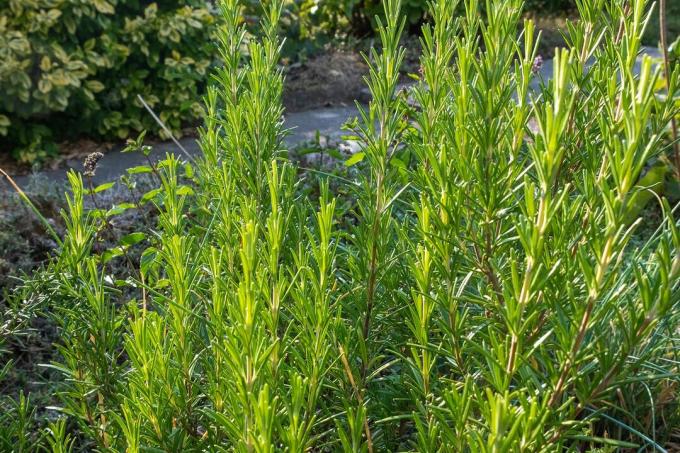
- Characteristics: Subshrub, evergreen, up to 1 meter high
- Plant: not always sufficiently hardy, winter indoors, outdoors from May
- Watering and fertilizing:water little and fertilize
- Cut: strong in spring cut back
- Harvest time: for fresh use at any time
- plant parts used: needles
Plants with S
sage (Salvia)
Only harvest the sage leaves when they are fully developed and the plant has not yet closed bloom begins. In this way, you promote continuous growth of the leaves of this spice plant and achieve good yields when growing it.

- Characteristics: predominantly shrub-like growth, up to 60 cm high
- Plant: outdoors from May, sunny, warm
- Watering and fertilizing: water and fertilize little
- Cut: cut back in March
- Harvest time: Summer
- plant parts used: Leaves
celery (Apium graveolens)
celery loves when the soil is moist and therefore needs to be watered regularly. Be careful when growing snails, caterpillars and other pests.

- Characteristics: Celery root or stalk, annual
- Plant: Grow indoors in mid-March, bright and warm, outdoors from May
- Watering and fertilizing: keep moist, fertilize regularly
- Cut: only for cut celery
- Harvest time: celery stalks from August, Celeriac from October
- plant parts used: tubers or sticks
Mustard, brown mustard (Brassica juncea), Black mustard (Brassica nigra) and White mustard (Sinapis alba)
Mustard is not only a popular spice, it is also considered a versatile remedy in traditional medicine. It has anti-inflammatory, digestive and pain-relieving effects.

- Characteristics: fast-growing, well suited as green manure, herbaceous plants, annual, up to one meter high
- Plant: sunny to partially shaded, prefer indoors from March, outdoors from May
- Watering and fertilizing: keep moist, fertilizer not necessary
- Cut: not necessary
- Harvest time: as soon as the pods are ripe
- plant parts used: seeds
Spice plants for cultivation with W
juniper (Juniperus communis)
Juniper is an evergreen shrub or tree that belongs to the family of Cypress family (Cupressaceae). With their spicy, slightly resinous and slightly bitter taste, juniper berries are often used as a spice used to give meat dishes, stews, game dishes and sauces a characteristic taste to lend.

- Characteristics: up to 8 meters high, slow-growing, evergreen coniferous tree, native
- Plant: sunny to partially shaded
- Watering and fertilizing: Do not allow young plants to dry out, otherwise they are easy to care for
- Cut: not necessary, but young shoots tolerate pruning
- Harvest time: from 3. year of standing
- plant parts used: Cones
Woodruff (Galium odoratum)
The leaves of the Woodruff Can be dried or used to refine sweets, desserts and ice cream. The herbaceous plant is also very popular in drinks, e.g. b. for flavoring May punch, lemonades and beer.

- Characteristics: small, herbaceous, perennial plant, up to 30 cm high
- Plant: Partial shade to shady, plant in spring
- Watering and fertilizing: water in dry conditions, fertilizing not necessary
- Harvest time: before flowering, April
- plant parts used: Leaves, but only for flavoring
Planting plan for spice plants
Here you can find ours Annual plan Download as PDF for growing spice plants:


frequently asked Questions
There are plants that belong to both herbs as well as spices. Although there is no clear difference, herbs usually only use the leaves of the plant, while with spice plants other plant parts such as seeds, flowers and rhizomes are also processed.
Most spices come from tropical countries and rely on a lot of heat and sun, so they can only grow all year round indoors or in a heated greenhouse. Some spice plants also require certain processing steps to develop their flavor. This applies, for example, to the popular vanilla, which comes from a type of orchid.
So that they do not lose their flavor, spices should always be stored in an airtight container, dry, cool and dark.

